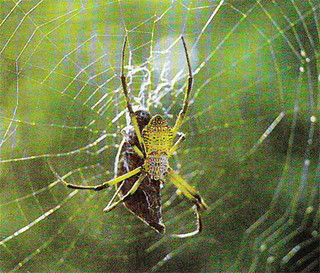Six classes of spiders found on Guam
There are 11 classes (i.e., major groups) of living arachnids in the world. Of these, only six are likely to be encountered on Guam: the Acari (ticks and mites), Pseudoscorpiones (pseudoscorpions), Scorpiones (scorpions), Solifugae (sun spiders), Opiliones (harvestmen or daddy long-legs) and Araneae (spiders).
The pseudoscorpions are only at most a few millimeters long and usually live in the leaf litter of the forest floor. They resemble scorpions with their clawed pedipalps (crab-like pincers), but the end of the abdomen is rounded and lacks a stinger. Sun spiders are quite spider-like in overall appearance, but rather more hairy, with close-set eyes and a large smooth head bearing formidable chelicerae (fangs). They live under rocks and rotting wood where they prey on other small arthropods. Harvestmen live in the forest and are seen in openings to caves and moist limestone karst.
By far the most commonly encountered arachnids on Guam are spiders. Unless otherwise noted, animal size indicates body length.
Cultural history
In CHamoru spiders are called sanye’ye, apayu’ak or, its apparent variant, payu’ak. None of the mites, pseudoscorpions, harvestmen or sun spiders are poisonous. The sole species of scorpion from Guam is small (to 4 centimeters or 2.5 inches), dark and has a sting that feels like that of a small ant.
While the North American black-widow spider is occasionally seen in shipments of material from the mainland, it has not established itself on the island. There is, however, a native spider Chiracanthium diversum whose bite, though not as venomous as that of the black widow, can still induce nausea. This spider is whitish to greenish, to 1 centimeter in body length with a somewhat flattened, crablike appearance.
The largest spider on Guam Heteropoda venatoria, brown with a leg-span to 10 centimeters (4 inches), is often seen on walls or in outdoor kitchens, especially at night. This species’ bite is not particularly toxic, but is painful because of the spiders’ large size.
Diversity and systematics
There are no comprehensive surveys of Guam’s arachnids, hence the number of species from the island is not known. The pseudoscorpions are good dispersers, being small and hitching rides on insects and birds, and the species can be broadly distributed in the Pacific. Hence, Guam likely has a good representation, over a dozen species, of at least the geographically widespread forms.
The small size, good dispersal ability and high ecological and geographic diversity of mites also indicate that Guam possesses a diverse fauna of these arachnids. There is one species of scorpion on Guam Hormurus australasiae, which is also widely distributed throughout Micronesia and the Western Pacific. The diversity of harvestmen and sun spiders is low and they are seldom seen.
Of Guam’s arachnids, spiders have been relatively more studied. Commonly encountered families include Araneidae (the orb-web weavers), Salticidae (jumping spiders) and Theridiidae (cobweb weavers). These families probably include spiders either endemic to the Mariana Islands or western Micronesia.
Ecology
At certain times of the year Guam’s jungles can seemingly become a maze of spider webs. These large webs belong to the communal-living spider Cyrtophora molluccensis also found on many other islands in the Pacific. The spiders build their webs adjacent to one another in groups of two to over 20 spiders. These group webs can be over 3 meters (10 feet) in height and inadvertently ensnare even moderately sized birds, which, however, are not captured or eaten by the much smaller spiders.
Further, the webs, unlike those of most other orb weavers, are not sticky. This appears to be an adaptation to a rainy climate. The webs are not as efficient snares as sticky webs, but only the latter become completely ineffective during frequent tropical rains. Upon closer inspection, these webs are seen to house other species of spiders, as well. These are species of Argyrodes, tiny (to 4 millimeters body length) web invaders that do not build their own web. The most common one has a high, silvered abdomen and may be found in the orb webs of another common Guam spider, Argiope appensa. Argiope is a large (to 3 centimeters), yellow spider that builds a flat vertical orb, often on roadsides or beach strand. Its web may also contain to four zigzag swatches of white silk radiating from the hub. Sometimes over ten silver Argyrodes may invade an Argiope web, stealing its prey and occasionally even eating the much larger host.
Travelers often comment on the seemingly high number of spider webs in Guam’s jungles. It has been speculated that this is an indirect effect of the demise of Guam’s bird fauna due to predation by the brown tree snake. It is thought that spider numbers have increased to take the niche formerly filled by insect-eating birds. However, episodically high densities of spiders are known from other islands whose bird faunas are relatively intact.
For further reading
Cunningham, Lawrence J., and Janice J. Beaty. Guam: A Natural History. Honolulu: Bess Press, 2001.
Guam Department of Agriculture Division of Aquatic and Wildlife Resources. Fish & Wildlife Fact Sheets. Mangilao: DAWR, 2002.





